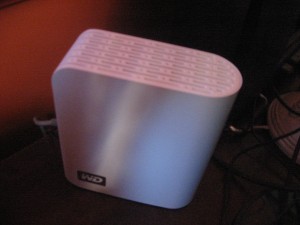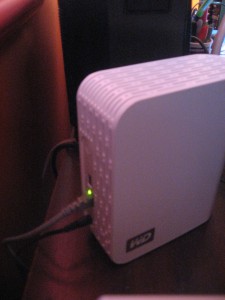A serious wireless router / NAS combo from LaCie – ready for next-generation broadband
My comments
There have been previous attempts to combine a network-attached-storage device with a broadband router but most of these have resulted in devices having the worst of two worlds unless you build a computer to work as this kind of device. Mostly you have a “storage router” which is a regular wireless “edge” router which can convert a USB-connected storage device in to a network-attached storage or a network-attached storage which can serve two networks and offer elementary routing functionality.
But LaCie have made a better attempt to bring the best of both worlds together. They have released the “Wireless Space” which is a NAS with integrated wireless-router functionality in a beautiful piano-black housing.
The network-attached storage can do what most single-disk systems can do such as offering integrated backup using operating-system-integrated backup functions that are part of Microsoft Windows or Apple MacOS X. Of course, files can be stored using the SMB or CIFS in a network-public share or a private share and the unit can provision media using UPnP AV / DLNA or Apple iTunes. One feature that I would like to know about with the UPnP AV media server is whether it can work with the full metadata for audio, image and video files or simply provide a folder view.
The unit can be set to work as a wireless “edge” router, a wireless access point or a wireless client bridge which provides for high flexibility, no matter whether you want to keep your existing broadband router going or replace it with something better. There are 3 Gigabit Ethernet ports for the LAN side of the connection and one Gigabit Ethernet port for the WAN (broadband) side of the connection, which makes this unit fit for use with “next-generation broadband” setups. The wireless network is based on 2.4GHz 802.11n technology and can use WPS quick-setup options.
When the unit works as a broadband router, it has the full expectation for a mid-range broadband router including UPnP Internet Gateway Device functionality and VPN pass-through. If it works as a switch, it can work alongside UPnP Internet Gateway Device routers to enable remote access to the network-attached storage resources.
It could have support for 4-port switch functionality when in switch mode rather than the 3-port switch + “recovery port” functionality that it has. As well, it could do well with support for WPS-assisted “extension access point” setup so it can work quickly and easily as part of an “extended service set”. Of course, I would prefer to hook this device to a wired backbone or run it as a wireless broadband “edge” router in order to avoid putting your data at risk due to the radio-interference risks associated with wireless networking and the fact that the wireless network is a shared-bandwidth network.
This may raise questions about this device being an “infill” NAS/access-point network device for a small network or being a replacement for an existing broadband router such as to “fatten the pipe” for next-generation broadband.


